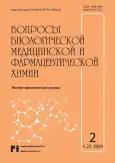Сравнительный анализ химического состава эфирных масел Thymus serpyllum l. И Thymus marschallianus willd. Методом газожидкостной хроматографии с масс-спектрометрическим детектированием
- Авторы: Шереметьева А.С.1, Караваева Л.В.1, Дурнова Н.А.1, Шаповал О.Г.1, Мухамадиев Н.К.2, Раббимова Г.Т.2, Назирбеков М.Х.3
-
Учреждения:
- Саратовский государственный медицинский университет им. В.И. Разумовского Министерства здравоохранения Российской Федерации
- Самаркандский государственный университет им. Ш. Рашидова
- Научный центр по контролю качества и оборота ветеринарных лекарственных средств кормовых добавок
- Выпуск: Том 27, № 2 (2024)
- Страницы: 48-56
- Раздел: Фармацевтическая химия
- URL: https://journals.eco-vector.com/1560-9596/article/view/627117
- DOI: https://doi.org/10.29296/25877313-2024-02-06
- ID: 627117
Цитировать
Полный текст
Аннотация
Введение. Эфирные масла растений являются природными источниками различных соединений, ведущее действие которых в макроорганизме определяется их химическим составом, зависящим от внешних факторов, в том числе видовой принадлежности растения.
Цель исследования – сравнительный анализ химического состава эфирных масел надземных частей тимьянов двух видов – Thymus serpyllum L. и Thymus marschallianus Willd. (Lamiaceae)
Материал и методы. Растительное сырье T. marschallianus собрано в Саратовской области в июне в фазу цветения, растительное сырье T. serpyllum приобретено в аптечной сети. Эфирные масла получены гидродистилляционым методом Гинзберга. Анализ химического состава эфирных масел проведен методом газожидкостной хроматографии с масс-спектрометрическим детектированием (ГЖХ-МС).
Результаты. Установлено, что основными компонентами эфирных масел обоих видов являются тимол и его изомеры: их массовая доля в эфирном масле T. marschallianus составляет 38,4%, в эфирном масле T. serpyllum – 43,88%. Статистически значимые различия
с вероятностью 95% установлены c помощью непараметрического критерия Манна–Уитни для трициклических сесквитерпеновых алкенов, суммарное содержание которых составляет в эфирном масле T. marschallianus 4,73%, в эфирном масле T. serpyllum – 3,59%.
Выводы. Химический состав эфирных масел T. serpyllum и T. marschallianu показал принадлежность их к фенольному хемотипу и сходство по мажорным соединениям.
Полный текст
Об авторах
А. С. Шереметьева
Саратовский государственный медицинский университет им. В.И. Разумовского Министерства здравоохранения Российской Федерации
Email: anna-sheremetyewa@yandex.ru
ст. преподаватель кафедры общей биологии, фармакогнозии и ботаники
Россия, СаратовЛ. В. Караваева
Саратовский государственный медицинский университет им. В.И. Разумовского Министерства здравоохранения Российской Федерации
Email: anhelokar@gmail.com
ассистент кафедры общей биологии, фармакогнозии и ботаники
Россия, СаратовН. А. Дурнова
Саратовский государственный медицинский университет им. В.И. Разумовского Министерства здравоохранения Российской Федерации
Email: ndurnova@mail.ru
д.б.н., доцент, заведующий кафедрой общей биологии, фармакогнозии и ботаники
Россия, СаратовО. Г. Шаповал
Саратовский государственный медицинский университет им. В.И. Разумовского Министерства здравоохранения Российской Федерации
Email: ogshapoval@gmail.com
к.м.н., доцент, кафедра микробиологии, вирусологии и иммунологии
Россия, СаратовН. К. Мухамадиев
Самаркандский государственный университет им. Ш. Рашидова
Автор, ответственный за переписку.
Email: m_nurali@mail.ru
д.х.н., профессор, кафедра физической и коллоидной химии
Узбекистан, Самарканд
Г. Т. Раббимова
Самаркандский государственный университет им. Ш. Рашидова
Email: gulnora_1968_r@mail.ru
к.м.н., доцент, кафедра акушерства и гинекологии № 2
Узбекистан, СамаркандМ. Х. Назирбеков
Научный центр по контролю качества и оборота ветеринарных лекарственных средств кормовых добавок
Email: mobeck@mail.ru
химик-аналитик
Узбекистан, ТашкентСписок литературы
- Tohidi B., Rahimmalek M., Arzani A. Essential oil composition, total phenolic, flavonoid contents, and antioxidant activity of Thymus species collected from different regions of Iran. Food Chem. 2017; 220: 153–61. doi: 10.1016/j.food-chem.2016.09.203.
- Diniz do Nascimento L., Moraes A.A.B., Costa K.S.D. et al. Bioactive natural compounds and antioxidant activity of essential oils from spice plants: new findings and potential applications. Biomolecules. 2020; 10(7): 988. doi: 10.3390/bi-om10070988.
- Nieto G.A. Review on applications and uses of thymus in the food industry. Plants. 2020; 9(8): 961. doi: 10.3390/plants 9080961.
- Truzzi E., Durante C., Bertelli D., et al. Rapid classification and recognition method of the species and сhemotypes of essential oils by ATR-FTIR spectroscopy coupled with che-mometrics. Molecules. 2022; 27(17): 5618. DOI: 0.3390/mo-lecules27175618.
- Vaiciulyte V., Loziene K., Taraskevicius R. Impact of edaphic and climatic factors on Thymus pulegioides essential oil composition and potential prevalence of chemotypes. Plants. 2022; 11(19): 2536. DOI: 10.3390/ plants11192536.
- Ebrahimi S. Nejad, Hadian J., Mirjalili M.H., et al. Essential oil composition and antibacterial activity of Thymus caramanicus at different phenological stages. Food Chem. 2008; 110(4): 927–931. doi: 10.1016/j.foodchem.2008.02.083.
- Шереметьева А.С., Дурнова Н.А., Березуцкий М.А. Содер-жание эфирных масел в траве разных видов рода тимьян (Thymus L.). Бюллетень Ботанического сада Саратовского государственного университета. 2017; 15(2): 15–19. doi: 10.18500/1682-1637-2017-15-2-15-19.
- Milenkovic L., Ilic Z.S., Sunic L., et al. Modification of light intensity influence essential oils content, composition and antioxidant activity of thyme, marjoram and oregano. Saudi J. Biological. Sci. 2021; 28(11): 6532–43. doi: 10.1016/j.sjbs. 2021.07.018.
- Hammoudi Halat D., Krayem, M., Khaled S., et al. Focused insight into Thyme: biological, chemical and therapeutic properties of an indigenous Mediterranean herb. Nutrients. 2022; 14(10): 2104. doi: 10.3390/nu14102104.
- Винокурова О.А., Тринеева О.В., Сливкин А.И. Сравнительная характеристика различных видов тимьяна: состав, свойства, применение (обзор). Разработка и регистрация лекарственных средств. 2016; 4: 134–50.
- Федоров А.А. Флора европейской части СССР: Т. 3. Л.: Наука, 1978; 259 с.
- Sidiropoulou E., Marugan-Hernandez V., Skoufos I. et al. In vitro antioxidant, antimicrobial, anticoccidial, and anti-inflammatory study of essential oils of oregano, thyme, and sage from Epirus, Greece. Life (Basel). 2022; 12(11): 1783. doi: 10.3390/life12111783.
- Aljabeili H.S., Barakat H., Abdel-Rahman H.A. Chemical composition, antibacterial and antioxidant activities of Thyme essential oil (Thymus vulgaris). Food Nutr. Sci. 2018; 9: 433–46. doi: 10.4236/fns.2018.95034.
- Дурнова Н.А., Романтеева А.Н., Ковтун А.Н. Химический состав эфирного масла тимьяна Маршалла и тимьяна Палласа, произрастающих на территории Саратовской области. Химия растительного сырья. 2014; 2: 115–19. doi: 10.14258/jcprm.1402115.
- Imelouane B., Amhamdi H., Wathelet J.P. et al. Chemical composition and antimicrobial activity of essential oil of thyme (Thymus vulgaris) from Eastern Morocco. Int. J. Agric. Biol. 2009; 11(2): 205–208.
Дополнительные файлы






